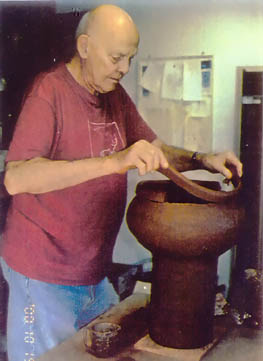From different molds
Riegger's work is primarily based on simpled utilitarian forms--bowls, goblets, storage pots and slab-like serving dishes--with surfaces that suggest the eart they are made of and the elements used in firing them. A rough oblong container set on squat legs seems snatched from the fire, signed and ashed; another simply formed and glazed a rust color, might be made of luscious mud.
Marked by a cultivated simplicility, Reigger's pieces seem to embody the spirit of Zen Buddhism and the Japanese tea ceremony. A rough, red, asymmetrical pot made of coarse clay seems to be caught in a state between being and nonbeing, springing up from the earth and returning to it simultaneously. A stunning white pot with a black neck and explosions of ashy residue on its body seems an accident of nature.
Several pieces in the show demonstrate Riegger's mastery of raku, an earthenware clay body fired with combustible organice materials such as leaves or sawdust. A pioneer in the American raku movement, the 88-year-old Reigger has taught at universities and art school all over the country and is the author of several texts and articles on raku, which reaches back to 16th century Japan and its tea ceremony.
In his current show, he gives us a pair of raku tea bowls that sum up the rustic elegance of the ceremonial ware, as well as a dish whose bright red crackle glaze is broken by a singed strip of black and a white drip in the center. A wall of ashy black clay is torn down the center where orange accretions of clay ooze from the rupture. All play on the asymmetry and subtle beauty of the imperfect. ...
|
